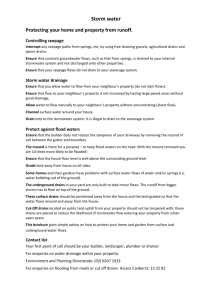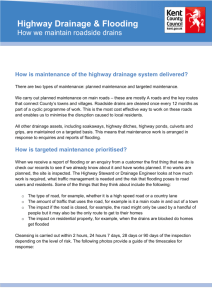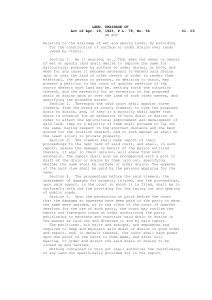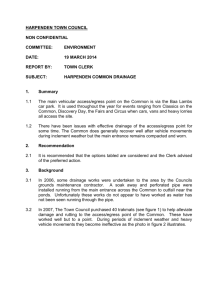ROADWORKS SPECIFICATION
advertisement
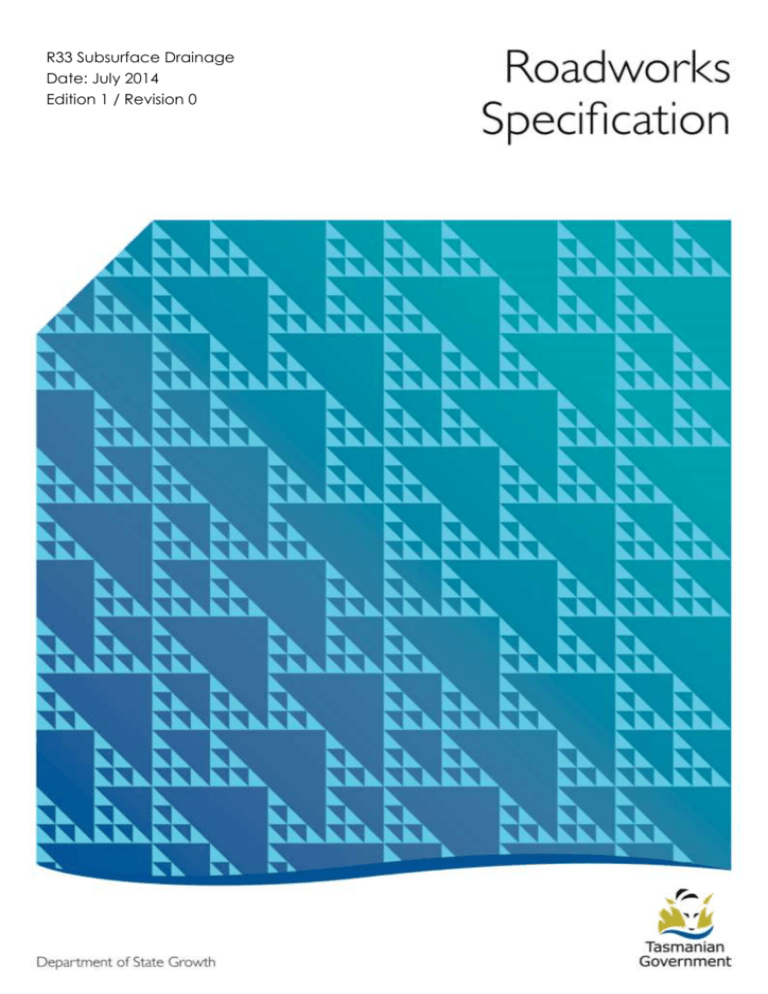
R33 Subsurface Drainage Date: July 2014 Edition 1 / Revision 0 R33 – Subsurface Drainage Department of State Growth REVISION REGISTER Ed/Rev Number Ed 1 / Rev 0 Clause Number All All All R33.1 R33.2-R33.4 R33.5 R33.5.1.1 R33.5.1.2 R33.5.1.3 R33.5.2 R33.6 R33.6.1 R33.6.2R33.6.3 R33.6.4 R33.6.5 R33.7 R33.8 R33.9 R33.10 Edition 1 / Revision 0 July 2014 Description of Revision ‘Department of State Growth’ replaces ‘DIER’ Term “geocomposite” replaces previous term “fin” Term “subsurface drainage” replaces previous term “subsoil drain” where relating to geocomposite drains Clause reworded New clauses added Replaces previous Clause R33.2 Replaces previous Clause R33.2.1, clause reworded Replaces previous Clause R33.2.3, new wording added Replaces previous Clause R33.2.4, clause reworded New clause added Replaces previous Clause R33.3 New clause added Replaces previous Clauses R33.3.1R33.3.4 Replaces previous Clause R33.3.5 Replaces previous Clause R33.3.6 Replaces previous Clause R33.4 Replaces previous Clause R33.5 Replaces previous Clause R33.6 New clause added Authorised By BW (MRA) Date 07.07.14 Page 2 R33 – Subsurface Drainage Index R33.1 R33.2 R33.3 R33.4 R33.5 R33.5.1 Page SCOPE OBJECTIVE REFERENCES AND STANDARDS DEFINITIONS MATERIALS Subsoil Drains R33.5.1.1 R33.5.1.2 R33.5.1.3 R33.5.2 R33.6.1 R33.6.2 Location Subsoil Drains R33.7 R33.8 R33.9 R33.9.1 R33.9.2 R33.10 Trenches Laying of Drains Backfilling and Compaction Outlets Flush Points DRAIN MARKERS EVIDENCE OF COMPLIANCE PAYMENT Subsurface Drainage Rock in Trenches HOLD POINTS Edition 1 / Revision 0 July 2014 Trenches Laying of Drains Backfilling and Compaction Geotextile Lining Geocomposite Drains R33.6.3.1 R33.6.3.2 R33.6.3.3 R33.6.4 R33.6.5 Geocomposite Drainage Material Filter Material Geotextile Filter INSTALLATION R33.6.2.1 R33.6.2.2 R33.6.2.3 R33.6.2.4 R33.6.3 Perforated Drainage Pipe Filter Material Geotextile Filter Geocomposite Drains R33.5.2.1 R33.5.2.2 R33.5.2.3 R33.6 Department of State Growth 4 4 4 4 5 5 5 5 5 5 5 6 6 6 6 6 6 6 6 6 7 7 7 7 7 7 7 8 8 8 8 8 Page 3 R33 – Subsurface Drainage R33.1 Department of State Growth SCOPE This specification sets out the requirements for the supply and installation of subsoil drains and geocomposite drains. R33.2 OBJECTIVE The objective of this specification is to ensure that subsurface drainage: is supplied and installed to Department of State Growth Standards using acceptable materials continues to function as intended after construction is complete. R33.3 REFERENCES AND STANDARDS The supply and installation of subsurface drainage shall be compatible with the provisions of all Department of State Growth Standard Specifications for Design, Construction and Maintenance, Austroads Guides and Test Methods and Australian Standards, in particular: Department of State Growth Standard Specifications G1 – General Provisions G2 – Contract Management Plan G3 – Traffic Management G6 – Production of Aggregate and Rock Products G8 – Construction Survey G9 – Product Quality R22 – Earthworks R24 – Geotextiles Australian Standards AS 2439.1 Perforated plastic drainage and effluent pipe and fittings – Perforated drainage pipe and associated fittings Other Standards and Test Methods ASTM D7001-06-Class B Standard specification for geocomposites for pavement edge drains and other high-flow applications ASTM D2412-10 Standard test method for determining external loading characteristics of plastic pipe by parallel-plate loading ASTM D6244-06 Standard test method for vertical compression of geocomposite pavement panel drains R33.4 DEFINITIONS Further to the documents referred to in Clause R33.3, the following definitions shall apply: Formation level – the general level of the surface of the ground, prepared or obtained, at the completion of the earthworks. Rock – as detailed in Standard Specification R22 Earthworks, Clause R22.4.2 Classification of Material to be Excavated. Pervious Pipe System – A pervious pipe system comprises drainage pipes which permit the entry of water from surrounding material and convey it to a discharge point. Such pipes may be perforated, slotted or porous pipes or impervious pipes laid with open joints. Subsoil Drain – A subsoil drain is a pervious pipe system laid in a trench and surrounded by granular filter material, with a geotextile placed lining the sides of the trench. Edition 1 / Revision 0 July 2014 Page 4 R33 – Subsurface Drainage Department of State Growth Geocomposite Drain – A geocomposite drain is a drainage system laid in a trench, comprising of a highly permeable core material wrapped in a geotextile surrounded by a granular filter material. Clear Water Opening – For geocomposite drainage material, clear water opening is the area of drainage slots expressed as a percentage of the area of the panel above the bottom of the lowest row of slots. R33.5 MATERIALS R33.5.1 Subsoil Drains R33.5.1.1 Perforated Drainage Pipe The pipes and associated fittings used in subsoil drains shall consist of Type 1 pipes of nominal outside diameter 100 mm complying with the requirements of AS 2439.1. The pipes shall also have a wall thickness of not less than 0.7 mm. Class 1000 pipes shall be used in all drains under the pavement where the pipe is within 1.5 metres of the pavement surface. Class 400 pipes shall be used in all other situations. R33.5.1.2 Filter Material Filter material shall consist of coarse, no-fines gravel, no-fines concrete, screenings or crushed rock with maximum particle size 19 mm and no more than 5% by mass passing the 4.75-mm sieve. The filter material shall not contain lumps of clay or organic matter. The Contractor shall test the granular filter material at a frequency which is sufficient to ensure that all materials supplied under the contract complies with the specified requirements but which is not less than that shown in Table R33.1 – Minimum Frequency of Testing. Test Grading R33.5.1.3 Table R33.1 – Minimum Frequency of Testing Minimum Frequency of Testing On each production day – One per 300 tonnes or part thereof Geotextile Filter The geotextile filter material used to line the subsoil drains shall comply with the requirements of Standard Specification R24 Geotextiles, Table R24.6 – Subsurface Drainage. R33.5.2 R33.5.2.1 Geocomposite Drains Geocomposite Drainage Material Geocomposite drainage material shall consist of a highly permeable, elongated high density polyethylene corrugated perforated or non-perforated core material, and must meet the requirements of ASTM D7001-06-Class B. The clear water opening for geocomposite drainage material must not be less than 3.5%. The load bearing characteristics of geocomposite drainage material shall comply with the requirements of Table R33.2 – Load Bearing Requirements. Table R33.2 – Load Bearing Requirements Property Test Method Requirement Horizontal Compressive ASTM D2412-10 Minimum 200kPa Strength at 20% Deflection Change in Core Area ASTM D6244-06 <5% loss in internal core area Edition 1 / Revision 0 July 2014 Page 5 R33 – Subsurface Drainage R33.5.2.2 Department of State Growth Filter Material Filter material shall consist of coarse, no-fines gravel, no-fines concrete, screenings or crushed rock with maximum particle size 19 mm and no more than 5% by mass passing the 4.75-mm sieve. The filter material shall not contain lumps of clay or organic matter. The Contractor shall test the granular filter material at a frequency which is sufficient to ensure that all materials supplied under the contract complies with the specified requirements but which is not less than that shown in Table R33.3 – Minimum Frequency of Testing. Test Grading R33.5.2.3 Table R33.3 – Minimum Frequency of Testing Minimum Frequency of Testing On each production day – One per 300 tonnes or part thereof Geotextile Filter Geocomposite drainage material shall be wrapped in a geotextile filter material. The geotextile filter material used shall comply with the requirements of Standard Specification R24 Geotextiles, Table R24.6 – Subsurface Drainage. R33.6 INSTALLATION R33.6.1 Location Unless indicated otherwise in the contract documentation, subsurface drainage shall be located as shown on the drawings. R33.6.2 R33.6.2.1 Subsoil Drains Trenches Trenches for subsoil drains shall be excavated to a minimum depth of 500 mm below formation level or as defined in the Standard Drawings. The trench for subsoil drains shall be at least 300mm wide. Generally, the bottom of the trench shall follow the grade of the formation and have a minimum grade of 1%. The trench shall be neatly excavated to the required line and dimensions. Subsoil drains may, where convenient, share a trench with other drainage pipes. For the purposes of payment, where the material to be excavated from trenches comprises hard, solid beds or masses that cannot be removed without blasting or use of pneumatic picks, hammers or wedges, then this material shall be classified as rock. R33.6.2.2 Laying of Drains Filter material shall be placed to a depth of 50 mm above the bottom of the trench before the pipe drain is laid. The drain shall not deviate from the intended line and grade by more than 40 mm and shall have a continuous fall. R33.6.2.3 Backfilling and Compaction Tamping of filter material around and over the pipe shall be done in such a manner as to avoid dislocation or damaging the drain, fittings or coverings. The method of compaction shall be detailed in the Contract Management Plan. R33.6.2.4 Geotextile Lining The geotextile lining of the drain shall have a minimum overlap of 250 mm on the top surface of the drain in the longitudinal direction, and 500 mm at transverse joins along the drain. Where the drain includes the sub-base layer the top of the drain shall remain 100mm below the top of the sub-base to facilitate grading operations. Edition 1 / Revision 0 July 2014 Page 6 R33 – Subsurface Drainage R33.6.3 R33.6.3.1 Department of State Growth Geocomposite Drains Trenches Trenches for geocomposite drains shall be excavated to a minimum depth of 500 mm below formation level or as defined in the Standard Drawings. The trench for geocomposite drains shall be 150mm wide. Generally, the bottom of the trench shall follow the grade of the formation and have a minimum grade of 1%. The trench shall be neatly excavated to the required line and dimensions. Geocomposite drains may, where convenient, share a trench with other drainage pipes. For the purposes of payment, where the material to be excavated from trenches comprises hard, solid beds or masses that cannot be removed without blasting or use of pneumatic picks, hammers or wedges, then this material shall be classified as rock. R33.6.3.2 Laying of Drains Geocomposite drainage may be placed on the excavated base of the trench. The drain shall not deviate from the intended line and grade by more than 40 mm and shall have a continuous fall. R33.6.3.3 Backfilling and Compaction Tamping of filter material around and over the geocomposite drainage material shall be done in such a manner as to avoid dislocation or damaging the drain, fittings or coverings. The method of compaction shall be detailed in the Contract Management Plan (CMP). R33.6.4 Outlets Subsurface drainage shall discharge into stormwater pipes, pits, manholes, table drains, natural waterways or from the edge of embankments. Where not connected to stormwater pipes, pits or access pits, subsurface drainage shall be provided with outlet structures as shown on the Standard Drawings. The 'dead' or high ends of the subsurface drainage shall be fitted with a plug or impervious cap. Outlets shall be installed at 120m maximum intervals. The location of outlets shall be recorded in the Completed Works Report. R33.6.5 Flush Points Flush points shall be installed in subsurface drainage to facilitate testing of the completed system to demonstrate compliance with this specification and to facilitate later flushing of the system as a maintenance procedure. The flush point shall be provided as either an open access to the drain or a minimum 50mm diameter pipe from the surface into the drain. Flush points shall be installed at 120m maximum intervals on longer pipe runs. The location of flush points shall be recorded in the Completed Works Report. R33.7 DRAIN MARKERS Drains shall be marked on the ground as follows: (i) Where it is practicable, star droppers with lemon-yellow triangular plates shall be placed at the fence line opposite the start and finish of the subsurface drainage and also opposite junctions, bends, flush points and sumps where applicable. Details of drain markers are shown on the Standard Drawings. (ii) In rock cuttings or where concrete kerbs are provided, lemon-yellow paint marks, approximately 75 mm x 150 mm in size, shall be used in lieu of the above markers. Edition 1 / Revision 0 July 2014 Page 7 R33 – Subsurface Drainage Department of State Growth The location of drain markers shall be recorded in the Completed Works Report. R33.8 EVIDENCE OF COMPLIANCE The Contractor shall demonstrate compliance with this Specification as a condition of payment. The method of demonstrating compliance shall be detailed in the CMP. R33.9 PAYMENT R33.9.1 Subsurface Drainage Payment for the installation of subsurface drainage shall be based on the rate quoted in the Schedule of Rates. The unit of measurement shall be linear metres. The rate for installation of subsurface drainage shall include the cost of excavation, supply and placing of geotextile and subsoil drainage pipe or geocomposite drain, supply, placing and compaction of bedding and backfill, supply and installation of flush points, endwalls and markers, connection to stormwater pipes if required, compliance testing and disposal of surplus excavated material. R33.9.2 Rock in Trenches Payment for the excavation of rock from subsurface drainage trenches shall be based on the rate quoted in the Schedule of Rates. The unit of measurement shall be cubic metres and shall be measured as a solid volume. Payment for excavation of rock shall be made only for the volume excavated from a trench width of 300 mm. The rate for excavation of rock shall include the cost of disposal of surplus excavated material. R33.10 HOLD POINTS The following hold points have been identified in this specification: Hold Points identified in this Specification are listed in Table R33.4 – Hold Points. Clause Ref R33.6.6 Description Flushing of subsoil drains and geocomposite drains Edition 1 / Revision 0 July 2014 Table R33.4 – Hold Points Nominated work Evidence of Compliance not to proceed Payment Evidence of flushing of the system that is satisfactory to the Superintendent. Page 8 R33 – Subsurface Drainage Edition 1 / Revision 0 July 2014 Department of State Growth Page 9
